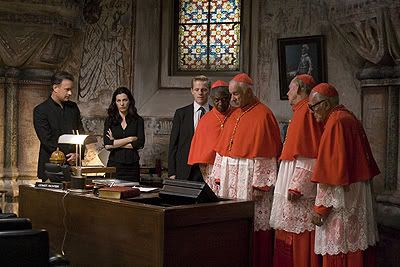
Angels & Demons, the second film based on a novel by controversial author Dan Brown, is better than its predecessor, The Da Vinci Code (2006). But that’s not saying much.
Tom Hanks is back as Harvard symbologist Robert Langdon, and Ron Howard is again in the director’s chair working from a script co-written by Akiva Goldsman (with David Koepp).
The murder of a scientist experimenting with antimatter, the theft of said antimatter, the kidnapping of four cardinals (all leading candidates to become the next pope) and the threat of the antimatter being used as a bomb bring Langdon to the Vatican—at the request of the Roman Catholic Church, no less—to assist in the investigation. Though Brown wrote this novel first, the movie is positioned as a Da Vinci Code sequel and the church is aware of Langdon’s particular expertise as a result of his previous adventure. A secret society known as the Illuminati—of whom Langdon has extensive knowledge—appears to be behind the plot.
Vittoria Vetra (Ayelet Zurer), the research partner of the murdered scientist, tags along with Langdon. He also gets aid from Camerlengo Patrick McKenna (Ewan McGregor), an aide to the recently deceased pope. Nearly everyone else, especially Commander Richter (Stellan Skarsgard) of the Swiss Guard, is unhelpful.
It’s a race against the clock, as the battery powering the device containing the antimatter will last only 24 hours—Where’s Jack Bauer when you need him?—and then go boom in a big way. The bad guys also have plans to start killing cardinals, one per hour.
Angels & Demons has more suspense built into its premise than The Da Vinci Code, and Howard responds with a livelier pace and more action-oriented approach. But the director and his writers cannot escape one simple fact: Brown’s writing is not cinematic. Long stretches consist of characters standing in rooms, giving each other history lectures. Howard has Langdon spout out information as he races from one location to another as he follows another set of obscure clues and riddles. He also has a fluid camera to avoid the stagelike feel that bogged down The Da Vinci Code.
The inherent dilemma will not go away so easily, though. Take the time to spell out the details in a clear, understandable way and you probably have a three- or four-hour movie. Try to keep the story moving without putting your audience to sleep and you have a parade of head-scratching revelations and twists.
Angels & Demons takes the latter approach, resulting in a film that moves quickly but never involves the audience.
So what does that leave us?
There’s Hanks, always a pleasure to watch and this time, without the oppressive, self-serious tone (and bad haircut) of The Da Vinci Code, getting to have a little more fun with his character.
There’s the cinematography by Howard’s frequent collaborator Salvatore Totino. The Vatican denied the production access, but exteriors shot in Rome combine with stage and effects work to create convincing images—to someone, like me, who’s never been there, at least.
And that’s about it.
Most of what I’m thinking about it how ridiculous it all is, from the bad guy (Nikolaj Lie Kaas) who’s a more efficient killer than a Terminator to the exploding-helicopter climax.
More bad news: Brown’s next Langdon novel, The Lost Symbol, will be published in September, and, if it's not already, I’m sure another movie will be in the works soon.
Grade: C-
(Rated PG-13 for sequences of violence, disturbing images and thematic material. 138 minutes.)
1 comment:
You are right, they probably have a film in the works for the new book which has been number 1 on Amazon's bestseller list for weeks already. I'm just hoping the book is as good as the others and I've created a page about The Lost Symbol. If you'd care to visit.
Brenda
Post a Comment